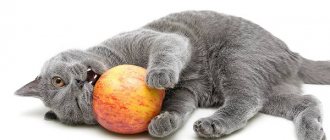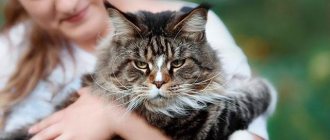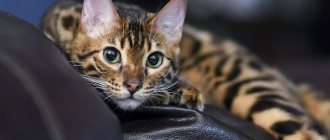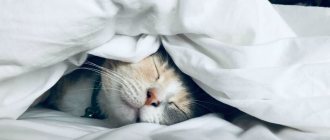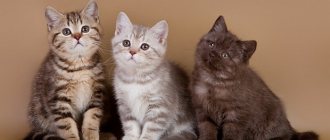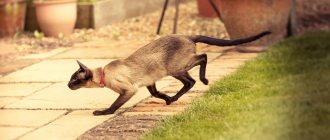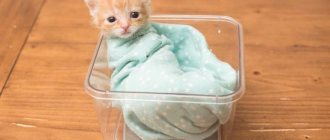British cats, both baby kittens and adult cats, need proper and healthy food. It is believed that this cat breed originates from the Cheshire cat from the famous Alice in Wonderland. In fact, the British cat breed was first recognized in 1871. This happened at the first London Cat Show.
Representatives of the British breed have a strong build, well-developed chest muscles, a not too long tail, strong dense paws, and a round head. The main features of the British are their dense coat, which looks like a plush coat of a special color, and a slightly flattened nose on the muzzle. There are more than 229 coat color options, each of which has its own standards. The blue shade of wool was considered classic, although other color options have now gained popularity.
British kittens of different colors.
How to choose the right British kitten
Sometimes you have to wait several months for a good pedigree baby from a specialized nursery. Usually kittens older than three months are given away from nurseries. At this age, babies receive all the necessary vaccinations. In the first month, the state of his health becomes clear. When choosing a baby, it would be a good idea to look at his parents along with photographs of the baby himself. You shouldn’t give up on the animal’s pedigree. Without this, even the most purebred cat becomes an ordinary yard cat. When choosing a little Briton, you cannot rely solely on his photographs.
It is better to find time and come to see your future pet in person. It is important to see it in your usual home environment. It is important to pay attention to his diet, what he is fed and what he likes. It is important to personally make sure that the animal knows what a litter box is. To do this, you will have to wait until the kitten goes to the toilet. Veterinarians advise listening to the cat - holding the cat to your ear and making sure that your furry friend does not have glanders.
At first glance this may seem strange, but the British breed sometimes has natural errors. The kitten may have deviated nasal septums and blocked tear ducts. This usually comes from the structural features of the skull.
If this is present, the animal’s eyes will constantly water and a characteristic noise will appear when breathing, similar to a quiet sniffle. When choosing a furry friend, many people advise checking the condition of his gums for the presence of gingivitis. This is not an uncommon occurrence for this breed.
Together with the animal, ask for its passport, which contains all the vaccinations given since birth. Many breeders give away his litter tray, favorite toys, and scratching posts along with the pet, but this depends on the person from whom the British baby is purchased. The breeder will also give some recommendations on care, feeding habits and other tips.
Feeding a British baby at 2 months
The first month of the furry baby's life has passed. His body now requires additional elements. Before feeding a 2-month-old British breed kitten, you need to study the list of acceptable foods necessary for proper growth and development.
Starting from 4-5 weeks of life, solid food can be gradually introduced into the menu. It is better to start with low-fat beef, previously frozen and finely chopped. For one feeding, a serving of 10-15 g is sufficient.
Your baby's diet should also include:
- fresh milk;
- delicious milk porridges cooked with low-fat milk;
- natural soft cheese;
- low-fat cream;
- egg yolk;
- fresh cottage cheese.
You can supplement the menu with pates and canned food purchased from specialized pet stores or veterinary pharmacies. The manufacturer's recommendations regarding age restrictions must be indicated on the packaging.
Experienced breeders do not advise buying cheap products of questionable quality. If you want to pamper your furry baby, buy him a good product from a reliable manufacturer!
Important:
- when introducing new foods into your lop-eared pet’s diet, monitor his body’s reaction;
- do not exceed the permissible limits when feeding the baby, overeating can be fraught with consequences;
- Don’t be lazy to cook separately for a purebred cat; he should not eat food with seasonings, spices and other additives typical of foods consumed by humans.
How to determine the sex and breed of a kitten
Usually cats give birth to several kittens. Immediately after lambing they are very small and wet. Outwardly, newborns do not at all resemble representatives of the cat family. Their appearance changes greatly within a few days after birth. They become covered in soft fluff and become tiny, cute little balls. The average weight and height of kittens up to one year old is shown in the table.
Average weight and height of kittens up to one year old.
After birth, questions arise about the gender of the kitten. It is possible to accurately determine gender only after several weeks. During this time, the baby will already be formed. Many people think that gender can be determined by the behavior of an animal. However, this is a misconception, as girls and boys can behave in exactly the same way.
It is best to entrust this issue to a veterinarian or an experienced breeder. There were cases when the owners believed that they had a cat Vaska. And a year later it turned out that this was Vasilisa’s cat.
Another erroneous method is to determine gender by the nipples on the stomach. This opinion is also incorrect. Both females and males have nipples, sometimes nipples can be more pronounced on girls, but this is also not the most objective or reliable way to determine gender. The sex of a kitten can be determined by the size of the animal. As a rule, males are larger and boys have larger heads than girls. Females have a more proportional build. This method also does not guarantee an accurate result.
Weight standard for adult cats
The weight of an adult cat also depends on age. A cat becomes an adult by the age of 1 year, when it reaches the end of puberty. By 12 months, the pet’s weight is 3.6-5.4 kg.
Sterilized animals gain weight faster, so a weight of 4.5-9.5 kg is considered normal for a male castrated animal, and from 2.5 to 6 kg for a female.
To track indicators, it is necessary to weigh the animal at the same time every day. British cats gain from 50 to 100 g in 24 hours, provided they have a balanced diet.
You can find out that your weight is normal using the following criteria:
- When cats are underweight, their ribs, sternum, and pelvic bones protrude greatly. The paws become thin, the lower abdomen is adjacent to the bones. Hair falls out a lot. When palpated in the chest area, no fatty tissue is felt.
- If a cat is obese, then its stomach sag greatly, even at the waist. The bones of the ribs, spine and pelvis cannot be felt due to excess fat. The animal moves slowly and refuses active play.
- In healthy cats with normal body weight, physiological proportions are clearly defined. The bones of the pelvis, ribs and sternocostal joints should not be visible. They have a well defined waist. The fat layer allows you to palpate the abdominal cavity and chest.
If your cat begins to rapidly gain weight and uncontrollably consume large amounts of food, it is necessary to conduct a preventive examination by a veterinarian to detect cardiovascular diseases.
Often these cats experience joint damage and the development of an inflammatory process in the joint capsule.
To normalize your weight, you will need to follow a diet. Gradually increasing excess weight has nothing to do with the sterilization of the animal. When a pet is castrated, its weight increases by only 1-3 kg. High-calorie foods are excluded from the diet.
In addition to meat and fish, the daily menu includes boiled chicken eggs, green peas, liver, dairy products and vegetables.
Where is the best place to get a kitten?
The choice of a cat of the British breed should be taken very seriously. You cannot purchase a pet from street vendors, markets, or in passages or subways. A self-respecting breeder who values his reputation will never take his “wards” out onto the street or into a public place. It is better to choose specialized breeders or nurseries. Be sure to check the reliability of this nursery. Breeders involved in the British breed can be found on special websites.
Vitamins
At your next visit to the veterinary clinic, you will undoubtedly be given a date when you need to vaccinate British kittens at 4 months. Regardless of vaccinations, you will need to give your pet vitamins.
- Please note that vitamins, supplements and other medications cannot be stored in places accessible to the British. It is clear that you do not feel sorry for them for your pet, but if he finds such a package and eats his fill, he risks getting poisoned.
- Only those animals that grow on homemade food need to be fed with special additives. Industrial feed already contains everything you need and does not require additional feeding.
- Contact with the street is inevitable, so kittens should be given pribiotics, like Lactoferon. It is especially important to update the British intestinal microflora if you live in the city. Before using the drug, be sure to visit a veterinarian!
All vitamins are divided into two groups:
- Complex . Here are vitamins with supplements so beloved by British cats. Sometimes there are special flavors that arouse the pet’s interest in such food not only at 4 months, but also in adulthood.
- Specific . These are vitamin supplements, vitamins with large amounts of calcium or other substances. This also includes special substances for removing hair from the body.
Remember that caring for a British kitten is quite a complex matter, and it is important to find out in advance what the baby will need at 4 months, so that in case of unforeseen circumstances you do not have to call your favorite doctor at three in the morning.
4 month old British baby © shutterstock
What to buy for a British kitten
Before a new resident appears in the apartment, you need to purchase the items that the kitten will need. You need to have everything you need in advance. This is necessary for the animal to cope well with the move to a new place of residence. This way the adaptation will be as comfortable as possible. The most necessary things to buy are:
- tray;
- tray filler;
- claw point;
- food bowls;
- water bowl;
- carrying;
- various toys;
- animal care items.
It is better to choose metal or ceramic bowls for food.
The cat should have at least three bowls - for water, for dry food, for wet food. It is better to choose a tray for the animal with high sides so that its contents do not spill out onto the floor or walls. To make cleaning the tray easier and more hygienic, you can purchase a special scoop for cleaning up waste. To prevent your pet from damaging furniture and walls, you need to purchase a special scratching post.
It can be a single column or a whole complex consisting of various blocks, houses, shelves. The scratching post should be covered with sisal or jute.
The first days of a kitten in the house
The long-awaited kitten has been brought. He is scared, cut off from his mother and familiar smells, and does not orient himself in an unfamiliar space. Usually the owner of the nursery gives detailed instructions on the care and maintenance of a British kitten.
Kittens are usually toilet trained at 2-3 months
To make getting used to your new home quick and painless, it is better to act as follows:
- There is no need to grab the kitten, squeeze it and try to immediately teach it to run after a toy - it will struggle, scratch and will perceive its future owners negatively. Therefore, it is better for new owners, especially children, to simply be in the pet’s field of vision, talking to it affectionately and calling it by name. The kitten must be given time to get used to it without scaring it. Soon he himself will come to the owner.
- If the apartment is large, and bowls of food and water and the toilet are located far from each other, then at first they can be placed nearby, but not next to each other. The kitten can be confined to one room for a couple of days, where everything it needs will be located. Then gradually expand the territory, opening doors to other rooms so that he does not get lost and gradually masters the entire apartment.
- In the first days, the animal must be fed with the same food as it was fed in the nursery. The change of food occurs gradually; for this, a new type of food must be gradually mixed into the usual one.
- Kittens are usually toilet trained at 2-3 months. The baby should be shown where his new toilet is by placing a napkin with the smell of his urine there.
The kitten must be given time to get used to its new home.
Having bought a cat, the owner will have to change his habits, and now:
- do not leave entrance doors open;
- install durable mosquito nets on the windows;
- including the washing machine, check its contents;
- close the toilet lid;
- close cabinets;
- watch where you want to sit.
It is important to be in the field of view of the new pet in the first days
How to care for a British kitten
There are several rules in caring for a British cat, following which, the cat will feel comfortable and safe. Proper care of a cat is the key to its health and long life. The main rule concerns nutrition. Since cats have developed muscles, they need a diet high in protein. The diet should also contain biotin, vitamins (especially groups A and B), and micro-macroelements. These elements have a positive effect on the color of the animal and the condition of its coat. The second rule of care is grooming. A cat needs to be accustomed to grooming procedures from childhood. The stages of grooming are:
- ear cleaning;
- teeth cleaning;
- combing;
The cat must be examined regularly. It is recommended to check the condition of your ears once a week and clean them if necessary. If there is a rash, irritation or unpleasant odor in the ear, you should seek veterinary help.
Nails need to be trimmed twice a month. Before doing this, you need to check the condition of the paws. You need to clean your eyes regularly. Black plaque accumulates in the corners of the eyes and needs to be removed. It is better to do this with a piece of cotton wool or a cloth soaked in warm water.
The British cat needs to be brushed regularly. It is often not necessary to carry out such a procedure, but some representatives of the cat family really like this procedure. You will need to purchase a comb. It is better that its teeth are made of soft rubber. Combing can be done according to the growth of the coat or against it. Such movements are an excellent massage; they improve blood circulation. You should not wash your animal frequently; it is better to carry out regular dry cleaning with special shampoos that do not require water.
Material on the topic: what is the British cat breed.
Character and features
An adult British cat does not often respond to affection and prefers to regulate the time and functionality of communication. The baby loves to frolic, plays with toys, runs after the beam of a laser pointer, and sometimes, in a good mood, purrs loudly. The pet readily lends itself to training, and by changing its habits it will tell the owner about the problem. Do not try to accustom a British kitten to being held by your hands; the nature of the British kitten includes demonstrations of tenderness.
Choose a unique name for your kitten.
When do kittens' eyes change color?
When purchasing an animal, many people pay attention to the color of its eyes. Indeed, this breed is distinguished by a beautiful shade of not only its coat, but also its eyes – gray-blue. But it is worth paying attention to the fact that as the cat grows up, it may change. It is impossible to determine the future eye color of small kittens. This can only be done a few months after birth, since by this time the animal will have completed its first molt.
It is possible to give a more accurate assessment of eye color only at one year of age, but by four months it is possible to predict the color. For the British, it depends on the coat color. At this age, experts will tell you whether the eye color will be yellow or dark orange. When choosing a small pet, it is best to pay attention to the health and condition of the eyes. They should not water, be cloudy, and the third eyelid should not be visible. The gallery below presents a selection of British kittens of different coat and eye colors.
Power change
If you suddenly change the diet, you can get diarrhea in a kitten at 4 months. Therefore, you should not risk the life and health of a Briton by rushing to switch to another type of food, but gradually introduce him to food. Gradually increase the amount of new food when you feed your baby, while decreasing the amount of old food.
A meat diet is a bad option, so do not give your pet only meat at 4 months. Although they are considered carnivores, they remain omnivores, eating both meat and vegetables equally. Therefore, the diet must be balanced.
Toilet training a kitten
Domestic cats usually have no problems with litter box training. In order for the kitten to understand this as quickly as possible, you need to approach this issue correctly and in a timely manner. The tray must be prepared before a new “tenant” appears in the house. As a rule, breeders train small kittens to use the litter tray in advance, before they are given to a new owner. In this case, all that remains is to buy a new tray and filler for it.
According to physiological characteristics, kittens go to the toilet immediately after eating. At first, you need to take your baby to the toilet immediately after eating. This way the kitten will understand what is required of him. You need to carefully grab the fluffy one by the belly and make sure that the kitten does “its business.” If the kitten went to the toilet in the wrong place, you should not shout at it, much less hit it. It is also not recommended to poke an animal into a puddle it has made.
Interesting read: all the information about British cats.
It is enough to tell the little one in a stern voice that they are unhappy with him. Cats understand human intonation. After this, you need to take the animal to the tray and rustle with the filler. The place where the “crime” occurred must be quickly treated with special cleaning agents so that the kitten is not drawn there by the smell. It must also be remembered that good toilet behavior is fully formed by six months. In order for a kitten to use the toilet correctly, the tray must first of all be comfortable.
Consequences of obesity in animals
Adipose tissue accumulates in the subcutaneous fat and around internal organs.
In the first case, there is a high load on the paws, metabolism is disrupted and physical activity decreases.
Visceral fat is much more dangerous: it compresses internal organs, disrupting their peristalsis.
As a result, the following problems arise:
- blood pressure increases, the functioning of the cardiovascular system is disrupted, and atherosclerosis develops;
- the cat gets tired quickly and sleeps more;
- hormonal balance is disrupted;
- vision problems arise - intraocular pressure increases, which increases the risk of developing glaucoma;
- diabetes mellitus develops;
- joint problems appear: osteoarthritis, gout;
- gastrointestinal tract disorder is observed;
- the risk of developing cancer increases;
- a disorder of the respiratory system occurs: frequent shortness of breath, hyperventilation;
- thirst appears;
- Metabolism is disrupted and immunity is weakened.
Raising British kittens
Individuals younger than 6 months are more amenable to training, and most of their skills are acquired before the age of three months. But this does not mean that it is impossible to accustom and educate a Briton older than this age. You can raise any pet and correct already acquired habits and habits. British cats have a good and developed level of intelligence and with sufficient attention and effort, she can be trained to meet her requirements.
Already existing bad habits cannot be unlearned with a simple “Don’t.” At the moment when the cat does something forbidden, you need to shout loudly, whistle or make any other loud sound. This will create a feeling of fear in the cat. But we must not allow the cat to become afraid of its owner. If the goal is to re-educate and, even more so, change the character of a British person, you need to be patient. This may take a long time. Don't scold the cat.
When the cat does what is required of it, the cat should be praised and given something tasty. If a cat sharpens its claws in the wrong place, for example, on furniture, walls, or chews on indoor plants, you can use several tips that work for British cats:
- You cannot scream or hit the animal. The pet may harbor a grudge against the owner or begin to be afraid of him.
- If he behaves badly, you can sprinkle water on him.
- Suddenly and imperceptibly clap your hands if the cat begins to do the forbidden.
- Spray the crime scene with an air freshener, preferably one with a citrus scent. Cats cannot stand this smell.
Raising British kittens is a simple process. This breed is easy to train and very intelligent. The main thing is for the cat to understand who is in charge in the house.
Feeding a British baby at 6-12 months
In the second half of the first year of life, the British reproductive system matures. This period is somewhat difficult both for the pet itself and for its owner. Some difficulties may arise when raising a British cat, which is already beginning to show its character.
In order for your furry friend to show maximum calm and not upset his owner with hooligan actions, it is necessary to continue proper nutrition, thanks to which the British dog will develop good behavioral manners and obedience.
What can you feed a British cat from 6 months of age:
- dairy products;
- egg yolk;
- boiled meat, frozen;
- boneless fish;
- porridges of different types;
- pieces of fruit and vegetables;
- crackers, rye bread;
- offal;
- ready-made canned food for cats by age;
- dry food is a priority, making up about 50% of the total diet.
From this age, the animal’s body no longer copes well with digesting lactose, so milk and milk cereals are gradually removed from the pet’s diet.
At 6-8 months, the number of feedings per day is 3 times; closer to a year, the number of meals is reduced to two times.
Feeding a one-month-old British kitten
Proper nutrition for a British person is a key factor in healthy development. There are two feeding methods - cooked food and ready-made food. Veterinarians are confident that the first option is better. With proper nutrition, the kitten receives all the necessary substances required for its small body. A one-month-old baby should be fed finely pureed meat. It is better to use beef and chicken for this.
You should not choose pork for this, as it contains too much fat, which negatively affects the animal’s digestive system. The diet should also include fermented milk products - kefir, sour cream, low-fat cheese. You need to feed your baby at least 6 times a day in equal portions. If you don’t have the time or energy to carry out these operations, you need to choose specialized food for small kittens. The main thing is that it is of high quality.
Feeding a one-month-old kitten.
Feeding a British baby at 1 month
Any living creature needs breast milk after birth, and the British baby is no exception. In the first month of life, a cat should be under the reliable care of its mother cat. Her milk contains all the components necessary for growth and development.
During this period, it is important to provide the cat with proper nutrition so that the remaining milk can receive all the necessary substances, thanks to which the kitten will develop a strong immune system.
If the nurse has some health problems, or for some reason the kitten cannot be under the care of the parent, the owners of a furry pet should develop a healthy diet for the newborn. So, what to feed a British kitten in the first month of life:
- In pet stores you need to purchase special milk for newborn kittens. This product contains a correctly selected composition of components, close to breast milk.
- Gradually, mashed egg whites and liquid semolina porridge cooked in skim milk can be added to the diet. Portions should be minimal. The number of feedings per day is 3-4 times. These foods are also included in the diet of breastfed kittens.
Kitten over six months old
For a teenage kitten, any products that he likes are suitable. The main thing is not to use products that can harm your health and cause suffering. Cats should not be given bones as they can damage their digestive organs. The diet should not contain poultry, lamb, or pork. These types of meat are poorly digestible for animals and can cause harm to them. Also, you should not give British leather all types of smoked meats, sausages, and frankfurters.
You should absolutely not give your pet sweet, salty or peppery foods. Products containing pepper can damage your cat's sense of smell. You should not add beans and potatoes to your food. These products negatively affect metabolism.
British kitten six months old.
Dry and wet food for the British
A more simplified method of feeding a British cat is based on ready-made food. This option is great for owners who are unable to regularly prepare healthy food for their pets. The main thing is to choose the right food and calculate the daily intake in accordance with the age of the kitten.
Responsible manufacturers create high-quality products that contain all the vitamin and mineral complexes necessary for the British. The range of such products includes a wide variety of compositions in dry and canned forms. When choosing, be sure to study the manufacturer’s recommendations published on the packaging!
Which food to choose, dry or wet, is up to you! You can combine these two types in an approximate ratio of 50/50, 60/40 or 70/30%. If the British cat is fed exclusively dry food, it is necessary to provide the animal with free access to clean drinking water.
The canned product is placed in a clean bowl in strictly measured quantities for one feeding. It is unacceptable to leave food “for later”; after each feeding, the animal’s bowl is cleared of product residues and thoroughly washed with clean water.
Advice from experienced breeders:
- For favorable growth and development, combine dry food with wet food. It is better to serve canned products for breakfast and dinner, and during the day you can feed your pet with dry food.
- Even if you feed your cat exclusively prepared food, regularly add pieces of fresh meat to the standard diet.
- The best food for a purebred British dog is premium (for example, Whiskas, Hills). Do not buy the budget version of the product, as these formulations do not contain enough necessary elements for proper growth and development. After feeding with cheap food, complications in terms of physical health are often observed. If you consume low-quality products, your kitten may develop urolithiasis and other chronic ailments.
- If you plan to castrate a mature British cat, buy special food with the appropriate label. These products contain a balanced complex of essential microelements, taking into account hormonal changes in the animal’s body. Similar rules are followed for cats that have been sterilized.
WHAT TO FEED A PREGNANT BRITISH CAT
What to feed a pregnant British cat: the diet remains the same. Add more beef, beef heart, liver. We do not overfeed the British cat - if you give too much excess food, and also high-calorie food, the kittens will grow too large and it will be difficult for her to give birth to them. Vitamins are also not recommended.
What is really important is the transition from regular dry food to food for pregnant women. Now almost every manufacturer has provided for this and has released special lines of food for pregnant cats, for example, Royal Canin QUEEN.
| In our cattery you can “buy a real British kitten.” We have many different colors, we will help you choose and answer all your questions! |
Things to consider
When choosing food, it should be remembered that the type of food that the owner uses in the first 6 months of a kitten’s life has a strong influence on the British cat’s food preferences. They may choose one type and refuse to eat all the others. To switch to a new type of food, they need a long time and gradual replacement of attractive food with a desirable product. You can avoid the formation of food preferences if you use complex commercial feeds.
It is also necessary to take into account that a kitten is a small tiger cub that needs a large amount of animal protein to grow. For health and vigor, a kitten needs 2 times more protein than a puppy, the same applies to fats.
This is due to the fact that the cat’s body is not able to independently synthesize essential amino acids such as taurine and arginine. Therefore, the British diet must include meat. In the wild, cats fed on animals and birds, eating them whole, which enriched the body with all the necessary micro- and macroelements.
Already in childhood, the British kitten is distinguished by its massive skeleton and well-developed muscles. To form a strong skeleton, the baby needs calcium and phosphorus. But they are not absorbed if there is not enough vitamin D3.
However, its excess can lead to negative consequences. To avoid this, you need vitamin K2, which is able to direct calcium to where it is needed, and not to the formation of kidney and gallstones. Magnesium is necessary for the biotransformation of calcium and phosphorus.
In addition to these nutrients, the diet of a strong Briton should include vitamins:
- A – so that calcium and phosphorus are deposited in bone tissue;
- B6 - activates the production of collagen fibers - the basis of tendons, articular cartilage, skin;
- C – also participates in collagen synthesis;
- PP – improves joint mobility;
- E – helps maintain articular cartilage elastic.
If the owner chooses professional ready-made food of high quality, then he will not have to calculate the amount of vitamins the baby needs - they are all there. But if the owner decides to feed the small predator with natural products, then he will have to introduce vitamin and mineral supplements into the diet.
The best vitamins for British kittens are Gimpet Baby Tabs. Children are gradually accustomed to them. Tablets (up to 10 pieces per day) are crushed and added to food. They differ in color and, in addition to basic vitamins and minerals, amino acids, contain additional:
- pink – fruit puree;
- green – seaweed.
Another feature of the British must be taken into account when drawing up a feeding schedule and calculating portions. Kittens of this breed grow simply rapidly. To provide the body with the energy and “building materials” necessary for growth and tissue formation, the amount of food should be large and amount to 10% of the kitten’s body weight per day. But since the baby’s stomach has a small volume, the daily requirement must be divided into portions:
- up to 6 months – by 4-6;
- from 6 to 8 months. – by 3;
- from 8 months - on 2.
Food can be left in constant access. The baby will eat exactly as much as necessary. Little Britons are not prone to overeating.
